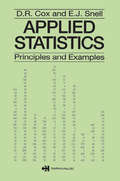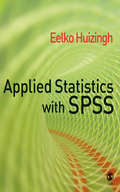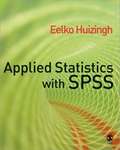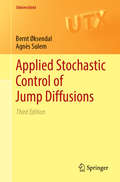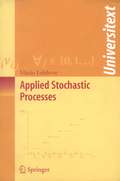- Table View
- List View
Applied Statistics in Social Sciences
by Emilio Gómez-Déniz Enrique Calderín-OjedaThis work is a detailed description of different discrete and continuous univariate and multivariate distributions with applications in economics and different financial problems and other scenarios in which these recently developed statistical models have been applied in recent years, including actuarial statistics (with emphasis on credibility theory, ruin theory, calculation of insurance premiums, etc.), stochastic frontier analysis (estimation of technical efficiency), duration models (intraday rate of trading), population geography, income and wealth distribution, physical economy, tourism and sports, among others. Each distribution is dealt with in a separate chapter along with descriptions of all possible applications. The authors also provide a detailed analysis of the proposed probabilistic families, discussing their relationship with existing models, statistical properties, analyzing their strengths and weaknesses, similarities and differences, different estimation methods along with comments on possible applications and extensions. Simulation methods are given for most of the models presented. Many of the probabilistic models shown along with their applications in the fields indicated are a result of numerous research articles published by the authors although others are also provided, mainly based on classical formulations, which have been the starting point of more general models. This volume contains an extensive updated bibliography selected from magazines and books on statistics, mathematics, economics, actuarial sciences and computer science. This book is an essential manual for researchers, professionals, professionals and, in general, for graduate students in computer science, engineering, bioinformatics, statistics and mathematics, since the concise writing style makes the book accessible to a wide audience.
Applied Statistics in Social Sciences
by Emilio Gómez-Déniz Enrique Calderín-OjedaThis work is a detailed description of different discrete and continuous univariate and multivariate distributions with applications in economics and different financial problems and other scenarios in which these recently developed statistical models have been applied in recent years, including actuarial statistics (with emphasis on credibility theory, ruin theory, calculation of insurance premiums, etc.), stochastic frontier analysis (estimation of technical efficiency), duration models (intraday rate of trading), population geography, income and wealth distribution, physical economy, tourism and sports, among others. Each distribution is dealt with in a separate chapter along with descriptions of all possible applications. The authors also provide a detailed analysis of the proposed probabilistic families, discussing their relationship with existing models, statistical properties, analyzing their strengths and weaknesses, similarities and differences, different estimation methods along with comments on possible applications and extensions. Simulation methods are given for most of the models presented. Many of the probabilistic models shown along with their applications in the fields indicated are a result of numerous research articles published by the authors although others are also provided, mainly based on classical formulations, which have been the starting point of more general models. This volume contains an extensive updated bibliography selected from magazines and books on statistics, mathematics, economics, actuarial sciences and computer science. This book is an essential manual for researchers, professionals, professionals and, in general, for graduate students in computer science, engineering, bioinformatics, statistics and mathematics, since the concise writing style makes the book accessible to a wide audience.
Applied Statistics in the Pharmaceutical Industry: With Case Studies Using S-Plus
by Steven P. Millard Andreas KrauseProviding a general guide to statistical methods used in the pharmaceutical industry, and illustrating how to use S-PLUS to implement these methods, the book explains why S-PLUS is a useful software package and discusses the results and implications of each particular application. It is targeted at graduates in biostatistics, statisticians involved in the industry as research scientists, regulators, academics, and/or consultants who want to know more about how to use S-PLUS and learn about other sub-fields within the industry, as well as statisticians in other fields who want to know more about statistical applications in the pharmaceutical industry.
Applied Statistics - Principles and Examples
by D.R. CoxThis book should be of interest to senior undergraduate and postgraduate students of applied statistics.
Applied Statistics - Principles and Examples
by D.R. CoxThis book should be of interest to senior undergraduate and postgraduate students of applied statistics.
Applied Statistics Using R: A Guide for the Social Sciences
by Mehmet Mehmetoglu Matthias MittnerIf you want to learn to use R for data analysis but aren’t sure how to get started, this practical book will help you find the right path through your data. Drawing on real-world data to show you how to use different techniques in practice, it helps you progress your programming and statistics knowledge so you can apply the most appropriate tools in your research. It starts with descriptive statistics and moves through regression to advanced techniques such as structural equation modelling and Bayesian statistics, all with digestible mathematical detail for beginner researchers. The book: Shows you how to use R packages and apply functions, adjusting them to suit different datasets. Gives you the tools to try new statistical techniques and empowers you to become confident using them. Encourages you to learn by doing when running and adapting the authors’ own code. Equips you with solutions to overcome the potential challenges of working with real data that may be messy or imperfect. Accompanied by online resources including screencast tutorials of R that give you step by step guidance and R scripts and datasets for you to practice with, this book is a perfect companion for any student of applied statistics or quantitative research methods courses.
Applied Statistics Using R: A Guide for the Social Sciences
by Mehmet Mehmetoglu Matthias MittnerIf you want to learn to use R for data analysis but aren’t sure how to get started, this practical book will help you find the right path through your data. Drawing on real-world data to show you how to use different techniques in practice, it helps you progress your programming and statistics knowledge so you can apply the most appropriate tools in your research. It starts with descriptive statistics and moves through regression to advanced techniques such as structural equation modelling and Bayesian statistics, all with digestible mathematical detail for beginner researchers. The book: Shows you how to use R packages and apply functions, adjusting them to suit different datasets. Gives you the tools to try new statistical techniques and empowers you to become confident using them. Encourages you to learn by doing when running and adapting the authors’ own code. Equips you with solutions to overcome the potential challenges of working with real data that may be messy or imperfect. Accompanied by online resources including screencast tutorials of R that give you step by step guidance and R scripts and datasets for you to practice with, this book is a perfect companion for any student of applied statistics or quantitative research methods courses.
Applied Statistics Using R: A Guide for the Social Sciences
by Mehmet Mehmetoglu Matthias MittnerIf you want to learn to use R for data analysis but aren’t sure how to get started, this practical book will help you find the right path through your data. Drawing on real-world data to show you how to use different techniques in practice, it helps you progress your programming and statistics knowledge so you can apply the most appropriate tools in your research. It starts with descriptive statistics and moves through regression to advanced techniques such as structural equation modelling and Bayesian statistics, all with digestible mathematical detail for beginner researchers. The book: Shows you how to use R packages and apply functions, adjusting them to suit different datasets. Gives you the tools to try new statistical techniques and empowers you to become confident using them. Encourages you to learn by doing when running and adapting the authors’ own code. Equips you with solutions to overcome the potential challenges of working with real data that may be messy or imperfect. Accompanied by online resources including screencast tutorials of R that give you step by step guidance and R scripts and datasets for you to practice with, this book is a perfect companion for any student of applied statistics or quantitative research methods courses.
Applied Statistics Using SPSS, STATISTICA, MATLAB and R
by Joaquim P. Marques de SáIntended for anyone needing to apply statistical analysis to a large variety of science and engineering problems, this book shows how to use SPSS, MATLAB, STATISTICA and R for data description, statistical inference, classification and regression, factor analysis, survival data and directional statistics. The 2nd edition includes the R language, a new section on bootstrap estimation methods and an improved treatment of tree classifiers, plus additional examples and exercises.
Applied Statistics Using SPSS, STATISTICA and MATLAB
by Joaquim P. Marques de SáAssuming no previous statistics education, this practical reference provides a comprehensive introduction and tutorial on the main statistical analysis topics, demonstrating their solution with the most common software package. Intended for anyone needing to apply statistical analysis to a large variety of science and enigineering problems, the book explains and shows how to use SPSS, MATLAB, STATISTICA and R for analysis such as data description, statistical inference, classification and regression, factor analysis, survival data and directional statistics. It concisely explains key concepts and methods, illustrated by practical examples using real data, and includes a CD-ROM with software tools and data sets used in the examples and exercises. Readers learn which software tools to apply and also gain insights into the comparative capabilities of the primary software packages.
Applied Statistics with SPSS
by Eelko HuizinghAccessibly written and easy to use, Applied Statistics Using SPSS is an all-in-one self-study guide to SPSS and do-it-yourself guide to statistics. Based around the needs of undergraduate students embarking on their own research project, the text's self-help style is designed to boost the skills and confidence of those that will need to use SPSS in the course of doing their research project. The book is pedagogically well developed and contains many screen dumps and exercises, glossary terms and worked examples. Divided into two parts, Applied Statistics Using SPSS covers : 1. A self-study guide for learning how to use SPSS. 2. A reference guide for selecting the appropriate statistical technique and a stepwise do-it-yourself guide for analysing data and interpreting the results. 3. Readers of the book can download the SPSS data file that is used for most of the examples throughout the book here. Geared explicitly for undergraduate needs, this is an easy to follow SPSS book that should provide a step-by-step guide to research design and data analysis using SPSS.
Applied Statistics with SPSS (PDF)
by Eelko HuizinghAccessibly written and easy to use, Applied Statistics Using SPSS is an all-in-one self-study guide to SPSS and do-it-yourself guide to statistics. Based around the needs of undergraduate students embarking on their own research project, the text's self-help style is designed to boost the skills and confidence of those that will need to use SPSS in the course of doing their research project. The book is pedagogically well developed and contains many screen dumps and exercises, glossary terms and worked examples. Divided into two parts, Applied Statistics Using SPSS covers : 1. A self-study guide for learning how to use SPSS. 2. A reference guide for selecting the appropriate statistical technique and a stepwise do-it-yourself guide for analysing data and interpreting the results. 3. Readers of the book can download the SPSS data file that is used for most of the examples throughout the book here. Geared explicitly for undergraduate needs, this is an easy to follow SPSS book that should provide a step-by-step guide to research design and data analysis using SPSS.
Applied Stochastic Control of Jump Diffusions (Universitext)
by Bernt Øksendal Agnès SulemHere is a rigorous introduction to the most important and useful solution methods of various types of stochastic control problems for jump diffusions and its applications. Discussion includes the dynamic programming method and the maximum principle method, and their relationship. The text emphasises real-world applications, primarily in finance. Results are illustrated by examples, with end-of-chapter exercises including complete solutions. The 2nd edition adds a chapter on optimal control of stochastic partial differential equations driven by Lévy processes, and a new section on optimal stopping with delayed information. Basic knowledge of stochastic analysis, measure theory and partial differential equations is assumed.
Applied Stochastic Control of Jump Diffusions (Universitext)
by Bernt Øksendal Agnès SulemHere is a rigorous introduction to the most important and useful solution methods of various types of stochastic control problems for jump diffusions and its applications. Discussion includes the dynamic programming method and the maximum principle method, and their relationship. The text emphasises real-world applications, primarily in finance. Results are illustrated by examples, with end-of-chapter exercises including complete solutions. The 2nd edition adds a chapter on optimal control of stochastic partial differential equations driven by Lévy processes, and a new section on optimal stopping with delayed information. Basic knowledge of stochastic analysis, measure theory and partial differential equations is assumed.
Applied Stochastic Control of Jump Diffusions (Universitext)
by Bernt Øksendal Agnès SulemHere is a rigorous introduction to the most important and useful solution methods of various types of stochastic control problems for jump diffusions and its applications. Discussion includes the dynamic programming method and the maximum principle method, and their relationship. The text emphasises real-world applications, primarily in finance. Results are illustrated by examples, with end-of-chapter exercises including complete solutions. The 2nd edition adds a chapter on optimal control of stochastic partial differential equations driven by Lévy processes, and a new section on optimal stopping with delayed information. Basic knowledge of stochastic analysis, measure theory and partial differential equations is assumed.
Applied Stochastic Modeling (Synthesis Lectures on Mathematics & Statistics)
by Liliana Blanco-Castañeda Viswanathan ArunachalamThis book provides the essential theoretical tools for stochastic modeling. The authors address the most used models in applications such as Markov chains with discrete-time parameters, hidden Markov chains, Poisson processes, and birth and death processes. This book also presents specific examples with simulation methods that apply the topics to different areas of knowledge. These examples include practical applications, such as modeling the COVID-19 pandemic and animal movement modeling. This book is concise and rigorous, presenting the material in an easily accessible manner that allows readers to learn how to address and solve problems of a stochastic nature.
Applied Stochastic Modelling (Chapman And Hall/crc Texts In Statistical Science Ser.)
by Byron J. T. MorganHighlighting modern computational methods, Applied Stochastic Modelling, Second Edition provides students with the practical experience of scientific computing in applied statistics through a range of interesting real-world applications. It also successfully revises standard probability and statistical theory. Along with an updated bibliography and
Applied Stochastic Models and Control for Finance and Insurance
by Charles S. TapieroApplied Stochastic Models and Control for Finance and Insurance presents at an introductory level some essential stochastic models applied in economics, finance and insurance. Markov chains, random walks, stochastic differential equations and other stochastic processes are used throughout the book and systematically applied to economic and financial applications. In addition, a dynamic programming framework is used to deal with some basic optimization problems. The book begins by introducing problems of economics, finance and insurance which involve time, uncertainty and risk. A number of cases are treated in detail, spanning risk management, volatility, memory, the time structure of preferences, interest rates and yields, etc. The second and third chapters provide an introduction to stochastic models and their application. Stochastic differential equations and stochastic calculus are presented in an intuitive manner, and numerous applications and exercises are used to facilitate their understanding and their use in Chapter 3. A number of other processes which are increasingly used in finance and insurance are introduced in Chapter 4. In the fifth chapter, ARCH and GARCH models are presented and their application to modeling volatility is emphasized. An outline of decision-making procedures is presented in Chapter 6. Furthermore, we also introduce the essentials of stochastic dynamic programming and control, and provide first steps for the student who seeks to apply these techniques. Finally, in Chapter 7, numerical techniques and approximations to stochastic processes are examined. This book can be used in business, economics, financial engineering and decision sciences schools for second year Master's students, as well as in a number of courses widely given in departments of statistics, systems and decision sciences.
Applied Stochastic Processes (Universitext)
by Mario LefebvreThis book uses a distinctly applied framework to present the most important topics in stochastic processes, including Gaussian and Markovian processes, Markov Chains, Poisson processes, Brownian motion and queueing theory. The book also examines in detail special diffusion processes, with implications for finance, various generalizations of Poisson processes, and renewal processes. It contains numerous examples and approximately 350 advanced problems that reinforce both concepts and applications. Entertaining mini-biographies of mathematicians give an enriching historical context. The book includes statistical tables and solutions to the even-numbered problems at the end.
Applied Stochastic Processes
by Ming LiaoApplied Stochastic Processes presents a concise, graduate-level treatment of the subject, emphasizing applications and practical computation. It also establishes the complete mathematical theory in an accessible way. After reviewing basic probability, the text covers Poisson processes, renewal processes, discrete- and continuous-time Markov chains,
Applied Structural Equation Modeling using AMOS: Basic to Advanced Techniques
by Joel E. CollierThis is an essential how-to guide on the application of structural equation modeling (SEM) techniques with the AMOS software, focusing on the practical applications of both simple and advanced topics. Written in an easy-to-understand conversational style, the book covers everything from data collection and screening to confirmatory factor analysis, structural model analysis, mediation, moderation, and more advanced topics such as mixture modeling, censored date, and non-recursive models. Through step-by-step instructions, screen shots, and suggested guidelines for reporting, Collier cuts through abstract definitional perspectives to give insight on how to actually run analysis. Unlike other SEM books, the examples used will often start in SPSS and then transition to AMOS so that the reader can have full confidence in running the analysis from beginning to end. Best practices are also included on topics like how to determine if your SEM model is formative or reflective, making it not just an explanation of SEM topics, but a guide for researchers on how to develop a strong methodology while studying their respective phenomenon of interest. With a focus on practical applications of both basic and advanced topics, and with detailed work-through examples throughout, this book is ideal for experienced researchers and beginners across the behavioral and social sciences.
Applied Structural Equation Modeling using AMOS: Basic to Advanced Techniques
by Joel E. CollierThis is an essential how-to guide on the application of structural equation modeling (SEM) techniques with the AMOS software, focusing on the practical applications of both simple and advanced topics. Written in an easy-to-understand conversational style, the book covers everything from data collection and screening to confirmatory factor analysis, structural model analysis, mediation, moderation, and more advanced topics such as mixture modeling, censored date, and non-recursive models. Through step-by-step instructions, screen shots, and suggested guidelines for reporting, Collier cuts through abstract definitional perspectives to give insight on how to actually run analysis. Unlike other SEM books, the examples used will often start in SPSS and then transition to AMOS so that the reader can have full confidence in running the analysis from beginning to end. Best practices are also included on topics like how to determine if your SEM model is formative or reflective, making it not just an explanation of SEM topics, but a guide for researchers on how to develop a strong methodology while studying their respective phenomenon of interest. With a focus on practical applications of both basic and advanced topics, and with detailed work-through examples throughout, this book is ideal for experienced researchers and beginners across the behavioral and social sciences.
Applied Structural Mechanics: Fundamentals of Elasticity, Load-Bearing Structures, Structural Optimization
by Hans Eschenauer Niels Olhoff Walter SchnellKundennutzen: Die wichtigsten Grundlagen der linearen Elastizitätstheorie, der Schalen- und Plattentheorie sowie der Strukturoptimierung werden in kompakter Form dargestellt. Zahlreiche Aufgaben und Lösungen helfen dem Leser den dargebotenen Stoff systematisch zu vertiefen.
Applied Summability Methods (SpringerBriefs in Mathematics)
by M. MursaleenThis short monograph is the first book to focus exclusively on the study of summability methods, which have become active areas of research in recent years. The book provides basic definitions of sequence spaces, matrix transformations, regular matrices and some special matrices, making the material accessible to mathematicians who are new to the subject. Among the core items covered are the proof of the Prime Number Theorem using Lambert's summability and Wiener's Tauberian theorem, some results on summability tests for singular points of an analytic function, and analytic continuation through Lototski summability. Almost summability is introduced to prove Korovkin-type approximation theorems and the last chapters feature statistical summability, statistical approximation, and some applications of summability methods in fixed point theorems.
Applied Surrogate Endpoint Evaluation Methods with SAS and R (Chapman & Hall/CRC Biostatistics Series)
by Ariel Alonso Theophile Bigirumurame Tomasz Burzykowski Marc Buyse Geert Molenberghs Leacky Muchene Nolen Joy Perualila Ziv Shkedy Wim Van der ElstAn important factor that affects the duration, complexity and cost of a clinical trial is the endpoint used to study the treatment’s efficacy. When a true endpoint is difficult to use because of such factors as long follow-up times or prohibitive cost, it is sometimes possible to use a surrogate endpoint that can be measured in a more convenient or cost-effective way. This book focuses on the use of surrogate endpoint evaluation methods in practice, using SAS and R.


